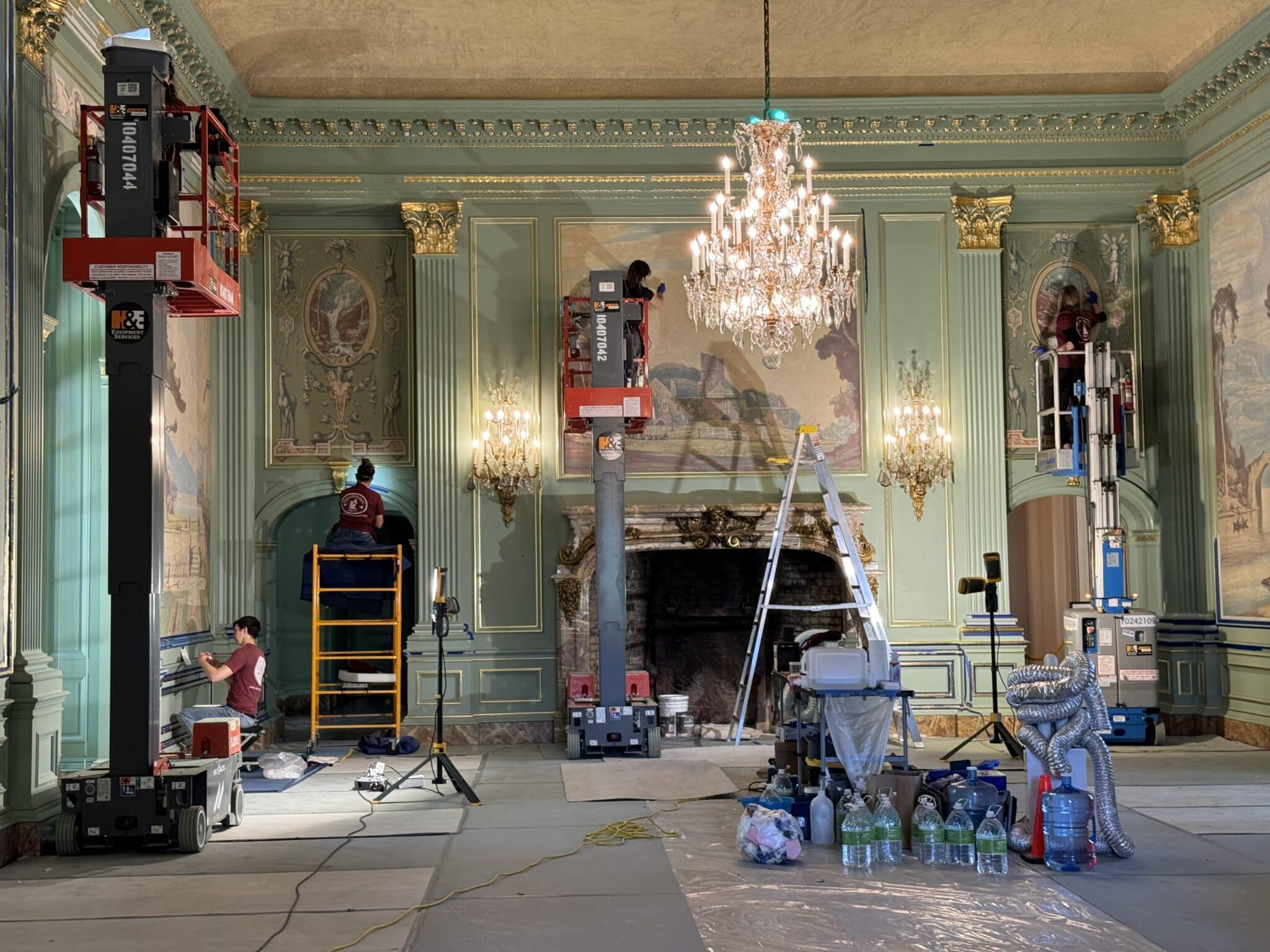Restoring the Ballroom’s Splendor

Did you know that Filoli is currently carrying out one of the biggest restoration projects in its history? Curator Kevin Wisney gives us a peek into the process.
The historic grand Ballroom at Filoli has hosted actors, singers, musicians, and even a sitting President of the United States. Agnes Bourn referred to the room as the “Music Room” and often relaxed there in an armchair listening to a phonograph. Lurline Roth hosted lush, elegant parties that went down in history. Weddings, cotillions, celebrations of life, and dinners of all sorts have graced the Ballroom’s floor.
Last year, the floors were restored to a rich tonal finish that highlights their elegant pattern – but it was clear that the Ballroom needed a comprehensive makeover. The wall color seemed off. The wooden baseboards looked like an afterthought. The gilt was glorious on the upper portion, but dingy and dull on the lower. And the canvases of Muckross by Ernest Peixotto were in dire need of cleaning.
What a tremendous amount of history has happened in that magnificent room! How could I ever undertake the daunting task of restoring it back to its original splendor? The task seemed monumental, but then I called on our talented partners to help sort it out.
Step One: Diving into the Archives
The obvious place to start was to go to the source: the letters in our archives between Agnes Bourn and Ernest Peixotto. Peixotto was not only creating the murals but also advising on the decor in the rest of the room.


Agnes Bourn in 1928. Ernest Peixotto in 1915.
Agnes Bourn writes to Mary Peixotto, Ernest’s wife, in 1924:
“Maude told us of the beautiful things Ernest is doing, and I do hope it may be possible when we come to have the Ballroom done that he may do it for us. Nothing has been attempted, and it has only had its priming. It is European and the mantelpiece is a temporary one, as Willis (Polk) was insisting on something monumental…”
Agnes Bourn writes to Mary and Ernest Peixotto in 1925:
“Ernest’s letter about the studio and interest in the Muckross panels is quite thrilling. I am sure they are going to be very fine. You have caught the most wonderful part of that wonderful bit of the world, the sky.”
These letters between Ernest and Agnes continue throughout the entire construction project, and they have helped my team understand how the Ballroom evolved and aged over the years. We also have a large number of photographs documenting it over the last century.

The Ballroom in 1927.
Step Two: Assessing the Room’s Condition
We asked our good friends at Architectural Resources Group to take samples from the Ballroom’s walls and use them to do an analysis of the composition of all the paint layers. The results revealed a number of secrets that the Ballroom was holding. We discovered that the gilt work on the lower portion of the room, which had dulled so much over the years that we thought it might just be paint, was indeed 24 karat gilt. Also, we found out that the original color of the walls was darker and richer than the way they appear today. This would mean that the paintings of Muckross would have been even more prominent and eye-catching on the walls.
Another partner, Preservation Arts, came out next to look at the Muckross paintings. Their team had recently performed the cleaning and restoration of the Dutch masterpiece by Jan Weenix that hangs above the Dining Room fireplace. Seeing the exquisite work they did on that, I knew our Ballroom murals were in excellent hands. They reported that the Muckross paintings were clogged with fireplace and cigarette smoke that had yellowed them considerably. Judging from the test spot they cleaned, the results of a full cleaning were going to be dramatic.
The Preservation Arts team also checked out the wooden baseboards, which were dark, nearly brown, and not cohesive with the marble in the room. I wondered if the baseboards had originally been painted to mimic the fireplace marble. Preservation Arts suggested we remove the exterior layer of varnish, as it had probably discolored over the years. There, hidden beneath, was the color Ernest Peixotto intended for the base boards all those years before!
Step Three: Starting at the Top and Working Our Way Down
First things first – the project started with the ceiling. The RFJ Meiswinkle Company repaired two obvious cracks in the crown molding, one on the east end of the room and the other on the west. The wear and tear of a century was obvious, so the plaster work needed much more repair than we thought.
Next, Rossi Painting arrived to repaint the entire room back to the original color chosen by Agnes and Ernest. They recreated Agnes’ vision down to the smallest of details – for example, painting the wide flat panels in a flat finish and the trim in a satin finish, as was her exact preference. When they finished, the room was refreshed – you can see how the blue-green walls support and highlight the murals magnificently.
Step Four: Eyes to the Floor
With tedious precision, the expert craftspeople from Preservation Arts then removed all the varnish and cleaned the paint on the baseboards. They had to lie sprawled out on the floor in order to reach each little spot. In the process, they returned the baseboards back to the work of art that they were intended to be!

I know when most people walk into the Ballroom, their eyes are drawn upward. But when the Ballroom is complete, I encourage you to make special note of the baseboards. They were so expertly and intricately painted to resemble marble. Even the seam between two pieces of marble is recreated, and the color and veining change as if the marble were real.
And this is where we discovered another secret the Ballroom was hiding. Expertly concealed in the veining of the painted marble baseboards was the signature of the artist who created them! The initials read either “MJR” or “MJK,” and we are investigating our records to see if we can find out more about this talented craftsperson.
Step Five: Going for the Gold
Next, it was time to get glitzy. Preservation Arts got a break from lying on the floor, and instead focused on restoring the gilded edges that line the walls. Using a technique known as oil gilding, they applied what’s called a “size” – think of it asfglor a kind of glue – to the painted surface. As the size begins to dry, it combines with the paint layer on a molecular level. Once the size is of a tacky consistency, the gold leaf is applied. This makes for a very resilient and sturdy surface.
This gilding work is painstaking and will take a while. While that part of the project progresses, the Preservation Arts team had a few members turn their attention to the paintings. Starting on the painting above the fireplace, they began removing a century’s worth of grime, revealing a bright and dynamic canvas beneath, including that brilliant Irish blue sky Mrs. Bourn alluded to in her letters.

Cleaning continues this August, and I am certain that the space has yet to give up all its secrets. The newly restored Ballroom is unveiled in September, and we invite you to come experience its splendor in person!
Historical photos courtesy of Filoli Archives
